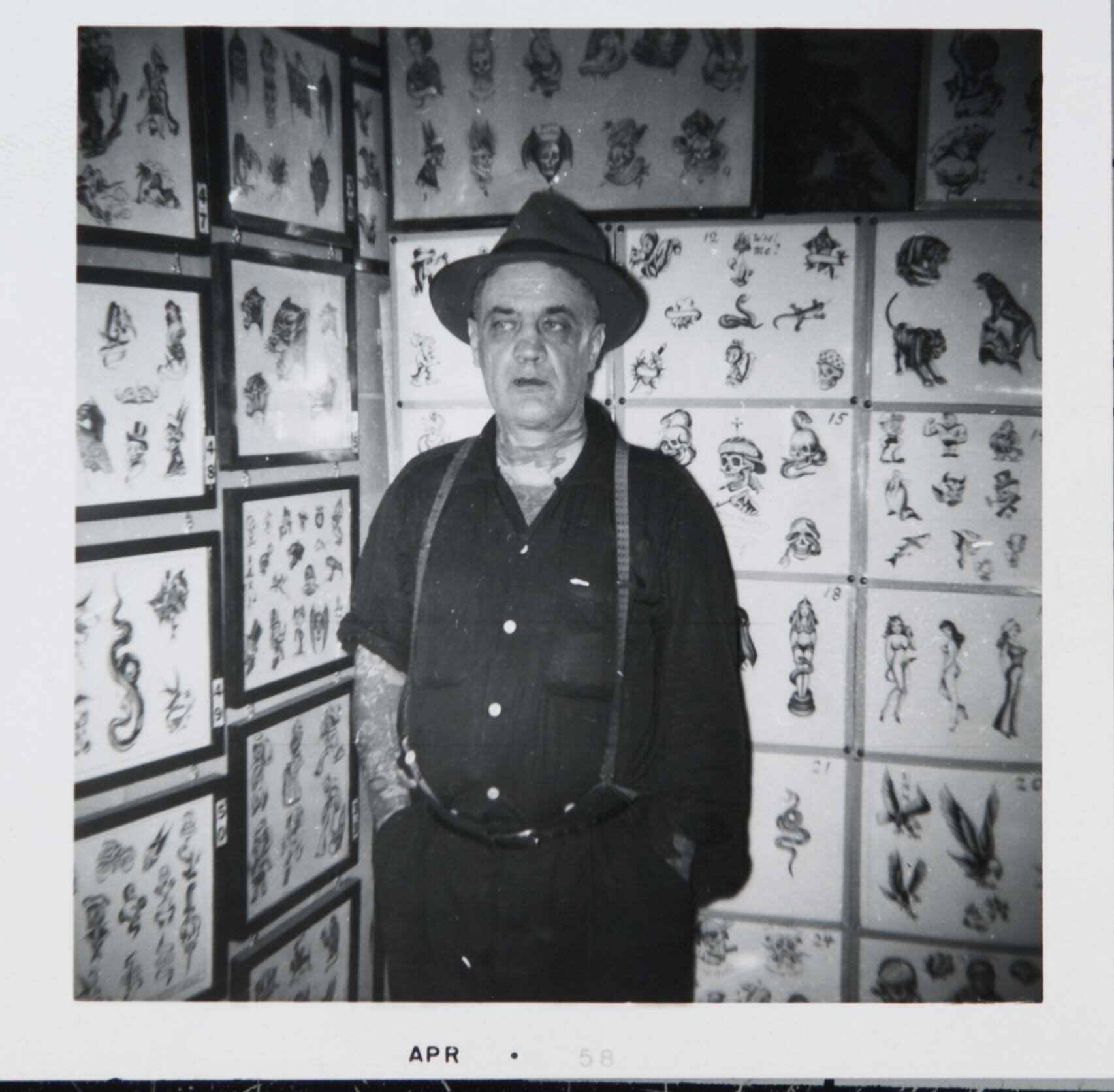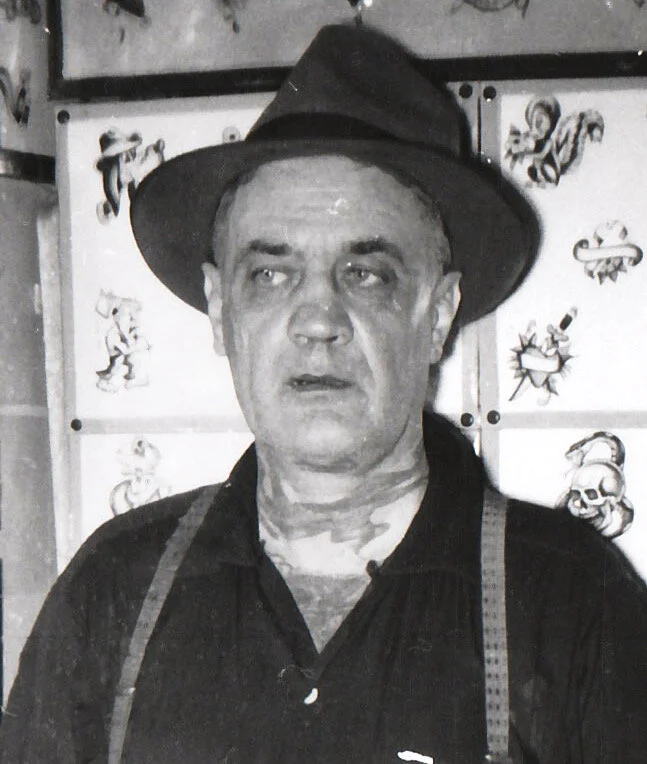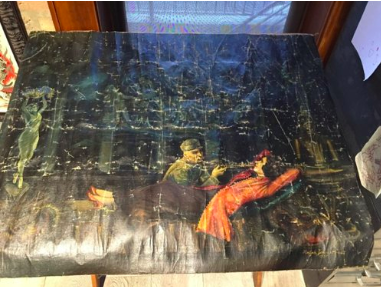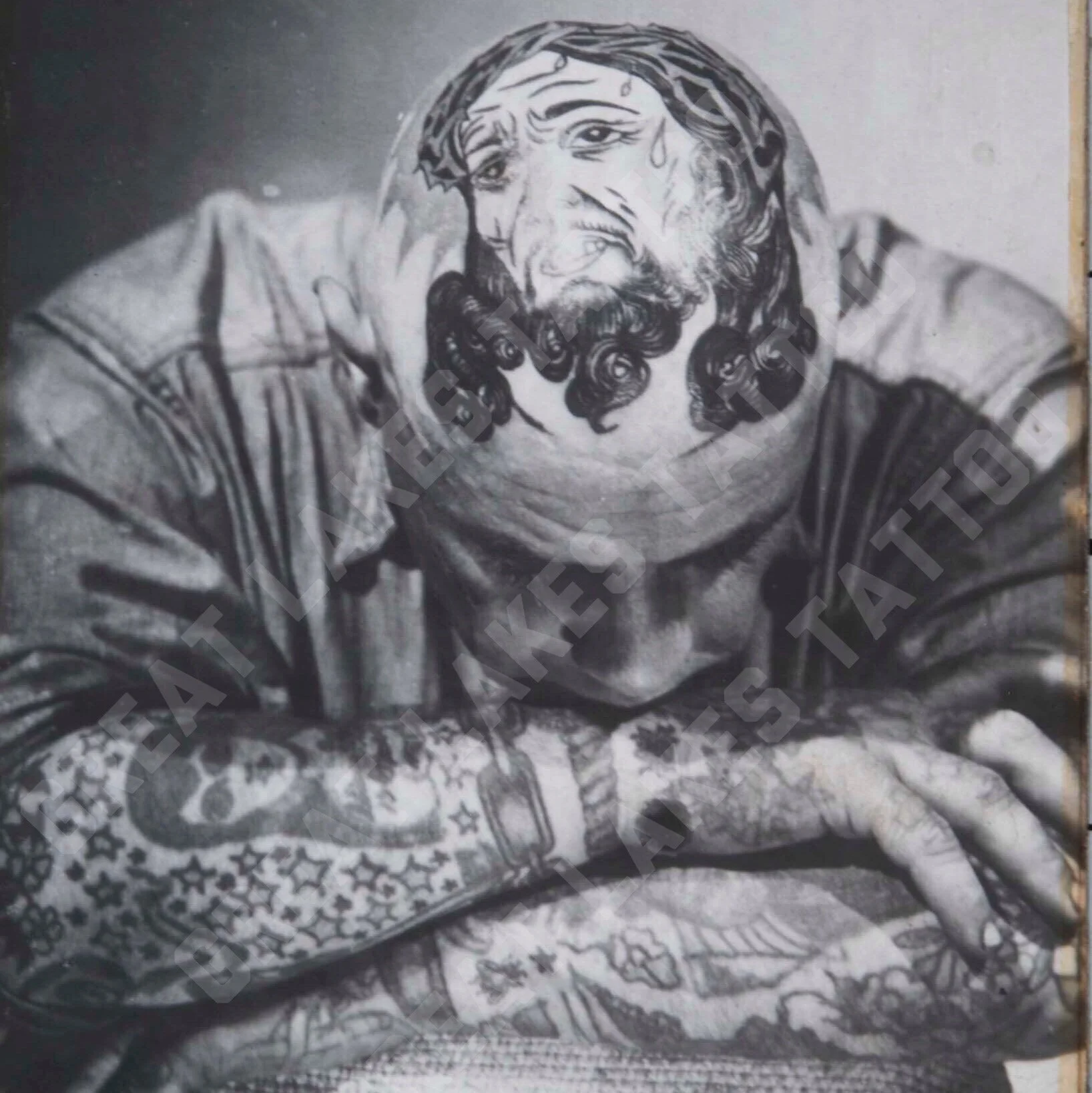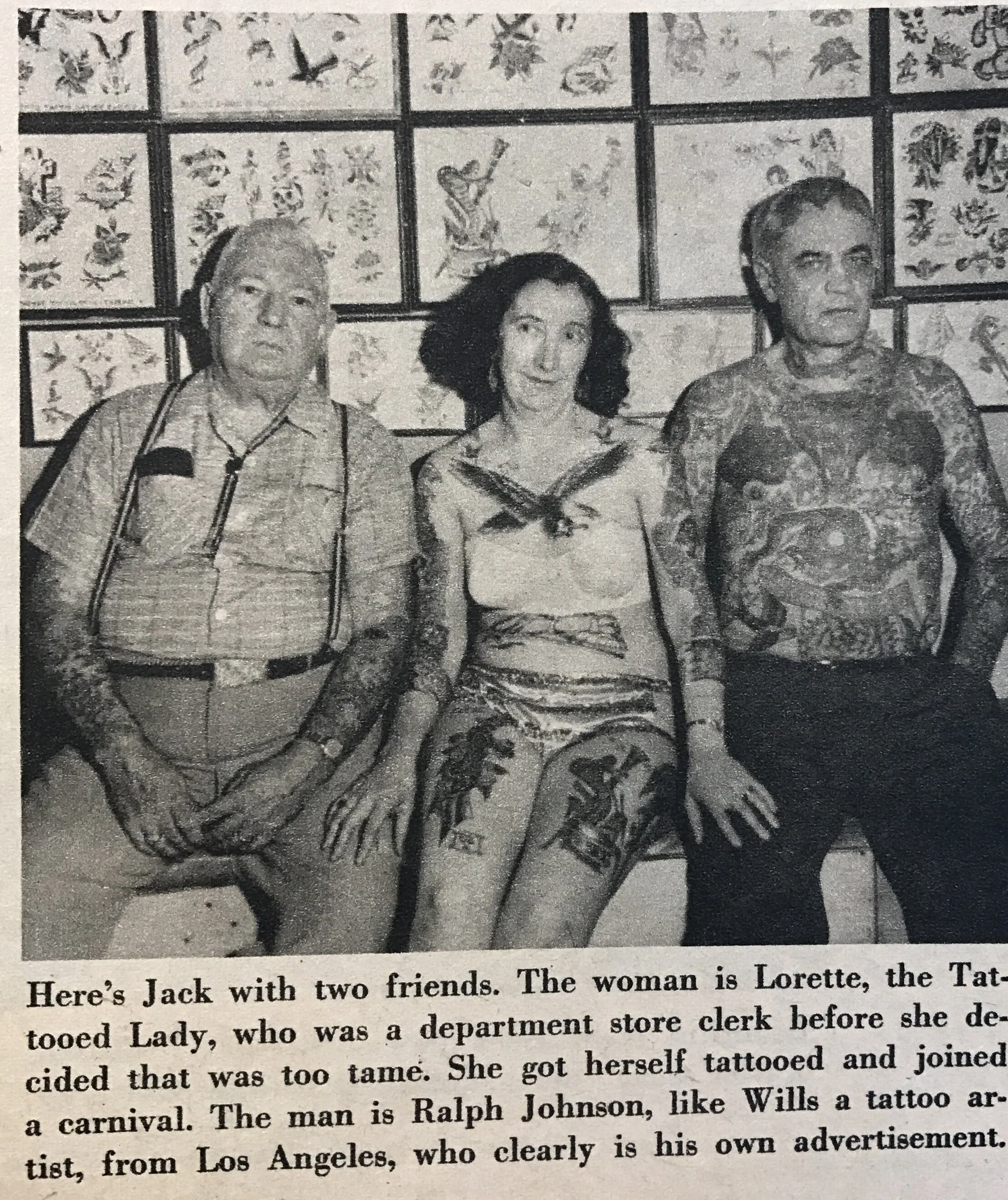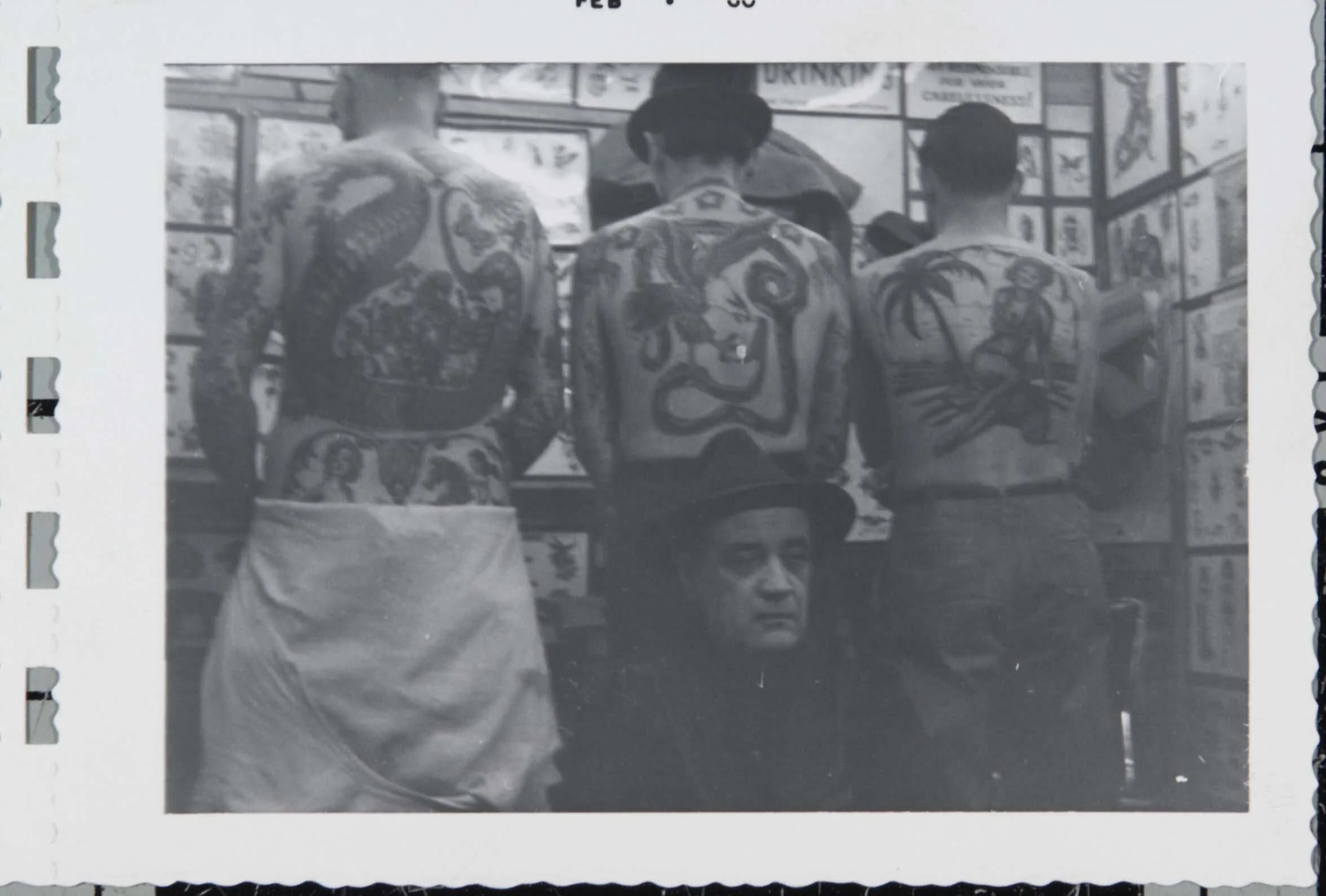Ralph Johnstone by Carmen Nyssen
Tattoo history is peppered with tattoo characters from all walks of life, whose varied skills and life circumstances have imbued the greater craftsmanship of the trade with immeasurable richness. Standing atop the artistic geniuses of the lot is Chicago’s Ralph Ernest Johnstone (1904-1960), an acclaimed master of nuance and refinery in both his tattoo application and tattoo flash. While the average tattooer of Johnstone’s day brought solid artistry and a personal hand to their work, his expertise in translating the exquisite details of his flash designs to human skin set him above. The painterly outlines, clever illusionary effects, and tonal shades of his flash work was at a higher level of execution on its own. For him to have infused the same qualities into his tattooing, in a day of hard-running machinery and a limited color palette, speaks to the full brilliance of his talent …not to mention to tattooing’s curious juxtapositions. For all his artistic flair, Johnstone navigated the tattoo world with a gruff, no-nonsense, cagy persona, “only a little tougher than a boarding house steak.” Yet, this rough exterior actually belied the truth of his formal childhood art training, a fact that somehow wasn’t passed-down through the lineages of tattooers. Whether Johnstone had deliberately hidden his privileged schooling from fellow tattooers, or his story simply wasn’t believed, there’s no denying the reality of it. The expansiveness of his artistic understanding is boldly demonstrated in all his creative undertakings—from his tattoo work to his carnival banner and show front paintings …and more.
It was in 2015 that perhaps the most telling example of Ralph Johnstone’s art education background surfaced, when Nick Colella of Great Lakes Tattoo was contacted by a woman who owned a very special relic of his career. The beautifully rendered, signed oil painting from 1937, depicting a bewitching opium den scene with hallucinations of a romantic tryst, is a veritable masterpiece—beyond what was typically seen in tattooing. The woman’s father had found the piece in the Erie, Pennsylvania print shop where he worked, and it was preserved in their family for many decades. In contacting Nick, she was hoping to learn more about its history. After speaking with him, however, and realizing his dedication to honoring the legacies of Johnstone and so many other Chicago tattooers, she felt compelled to place it in his care. Though it was in battered condition, Nick and his wife Sarah dutifully had it restored, and it now holds a prominent place on their tattoo shop wall as visual evidence of Johnstone’s shining artistic gifts—those he had been honing since the time of his youth.
Between his sideshow and tattoo gigs around the county, by the end of the 1940s decade, Johnstone had solidified his name as an artist in all his realms of employment. In 1947, Rockford, Illinois tattooer Milton Zeis paid great tribute to him in his Tattooing the World Over booklet, by captioning a photo of Johnstone’s tougher-than-nails Tatts Thomas “Christ head” scalp tattoo as such: “The wearer is Sailor Russ (Ralph Johnson) [sic] who is also an expert tattoo artist, also is a wonderful side show banner painter. Gets excellent likenesess [sic] of the portraits of the side show people. “Johnstone was no less revered by fellow carnival employees. In 1949, he joined Ray Cramer’s Metropolitan Railroad sideshow, as a scenic artist and “human art gallery,” under auspices of the newly formed Dodson’s Imperial Show. The show’s magician, the Great Vanteen, remembered him well, stating he was “very eccentric, but a great artist!” In 1953, Johnstone met famed sideshow operator Ward Hall, who was unequivocally impressed with his artistic abilities. In July of that year, Johnstone took a ‘scenic painter’ position with Al Wagner’s Cavalcade of Amusements, where Hall was operating his sideshow. In a 2015 phone conversation, Hall reminisced how he didn’t know if the story Johnstone told him about studying art abroad was true, but he had certainly never seen such beautiful paintings. In fact, he was so taken with the gorgeous show wagon scenes—full of leaping tigers, elephants, and clowns—that he allowed Johnstone to set-up a tattoo booth in his tent at night. He said Johnstone’s tattoos were “absolutely beautiful—he was a real artist, not a jagger;” he never used stencils and he’d draw magnificent pictures right onto the skin, including portraits of men’s girlfriends “from life.” In such demand was Johnstone’s tattooing that he often continued working until 2 or 3am, after the sideshow closed at 11 p.m. Tattooer Leonard “Stoney” St. Clair was another huge fan and claimed Johnstone was & quote; one of the greatest tattooers that ever lived.” In an interview for Alan Govenor’s book Stoney Knows How, Stoney said he had witnessed Johnstone’s work in Phenix City, Alabama, where Johnstone had fled after an incident involving Chicago’s mob-controlled tattoo racket. Whether Stoney’s mob tale is true or not, Johnstone landed near Phenix City in the late 1940s, where he joined Dodson Imperial Shows. The show’s winter Quarters was located in Columbus, Georgia, across the Chatahoochee River, a mile away from Phenix City. A Columbus (GA) Daily Enquirer newspaper article also places him tattooing there in 1954. In the couple years or so before and afterward, Johnstone continued spreading his top-notch skin art as far west as Los Angeles, San Diego, and Oceanside, before finally heading back to his favorite stomping grounds.
While Johnstone clearly made a coast-to-coast name for himself via his travels, he is most strongly tied with Chicago’s tattoo history. Throughout the years, the city’s gritty tattoo scene served as his headquarters, and ultimately, the backdrop of his illustrious career. Whatever the fallout from the mob situation, by the late 1950s, he had returned there permanently and partnered with premier tattoo artist Tatts Thomas. It was during these last days of his life that he tattooed several of his most memorable pieces, including a Marilyn Monroe portrait and a backpiece depicting the famous “raising the flag on Iwo Jima” scene on Eddie Lynch. The latter composition was so spectacular Lynch was known as “Iwo Jima Eddie” forevermore. An article in a March of 1959 Man’s Magazine likewise pronounced it Johnstone’s masterpiece. In fully consecrating Johnstone’s legacy, the same 1959 article goes on to praise his inventiveness in customizing tattoo designs as well as his passion for his art: “Unlike the percentage of tattooers whose ability is in direct proportion to the excellence of their stencils, Johnstone beams when called on to create some new design for back, belly, or thigh.” Johnstone died on November 14, 1960 at the age of 56. Up until the end, he was hailed for his incredible artistic skills. From skin to banners and canvas, he created masterworks all around and carved out a grand niche that upheld his talents in a far more unique—though no less expressive or prolific—way than he probably imagined when he commenced his art studies as a young boy in Germany. As far as tattoo traditions are concerned, his renowned holds all the more profoundly through his iconic tattoo designs that have been iterated across generations and are continually executed with renewed spirit to this day. End Note:
1952 Jan 19 Pittsburgh Sun-Telegraph pg. 5: Tax Refunds: “Ralph E. Johnstone, 331 South Main St., Los Angeles, Cal.”
1955 Mission on Main Street by Helga Bender Henry: & quot; Professor Ross in his tattooing studio [between third and fourth] offers 2,000 designs in the brightest colors by an electric process; across the street another studio boasts 5,000 designs"
*It’s not clear if the tattooed man “Sailor Ross,” who was traveling with the Nat Reiss show in 1925, was also
Johnstone.


